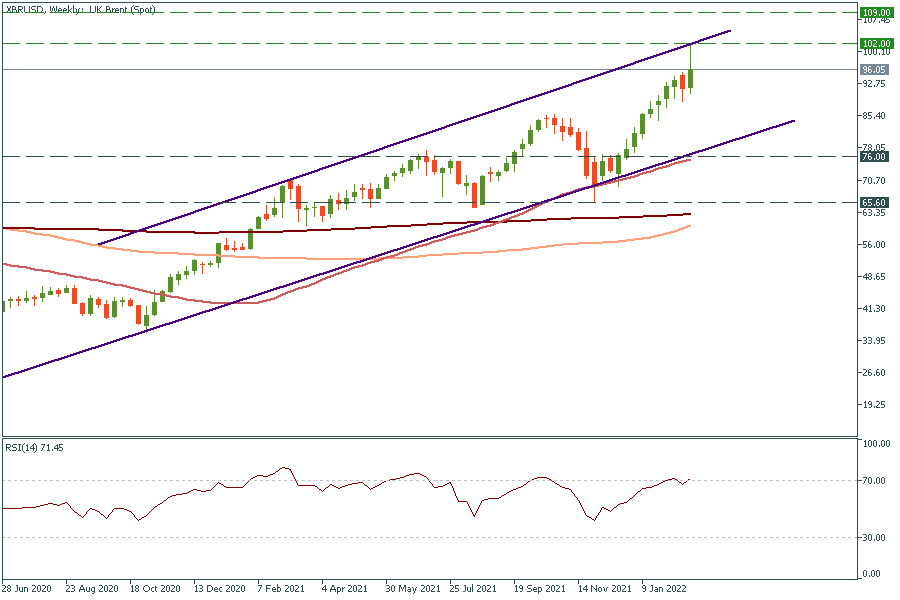Petrol: 100$'a Ulaştı, Sırada Ne Var?
Petrol piyasasında sakinlik yok; tarih bunu bize öğretti. Pandemi 2020'de başladığından beri, Mayıs 2020 WTI ham petrolünün varil başına eksi 37.63$'dan bu Şubat ayındaki 100$ seviyesini kırmaya kadar petrol fiyatlarında iniş ve çıkışlar gördük. Şuan işlemciler, rallinin devamını mı yoksa kaçınılmaz bir düzeltmeyi mi beklemeleri gerektiğini merak ediyor. İlk durumda, fiyat 2012'nin en yüksek seviyelerinin üzerine çıkabilir. İkinci senaryoda, 2015-2016'dakine benzer ağır bir düşüş göreceğiz. Bu sefer hangi durumunn hayata geçmesi muhtemel?
Petrol fiyatlarını etkileyen faktörler
Öncelikle petrol fiyatlarını yönlendiren başlıca faktörleri gözden geçirelim. Diğer her bir emtia gibi, petrol de büyük ölçüde arz ve talep yasasına bağlıdır. ABD, Suudi Arabistan, Rusya, Kanada ve Çin dahil olmak üzere önemli petrol üreticisi ülkelerden gelen arz seviyeleri petrol fiyatlarını etkiliyor. Düzenli arz akışının kesilmesi petrol fiyatlarını yükseltir. Aynı zamanda, fiyat seviyelerini desteklemek için petrol talebinin yüksek kalması gerekiyor.
İkinci faktör, Petrol İhraç Eden Ülkeler Örgütü (OPEC) ile bağlantılı. 1960 yılında kurulan 13 üyeli bu örgüt, petrol üretim seviyelerini düzenlemekte ve petrol fiyatlarına yön vermektedir. 2016 yılında, daha büyük bir petrol üretici grubu olan OPEC+ kuruldu. Yenilenen ittifak, petrol rezervlerindeki varil sayısını kontrol etmek için yılda birkaç kez toplantılar yapıyor.
Doların performansındaki değişim de petrol fiyatlarını yönlendiren bir diğer faktör. Emtia fiyatları genellikle ABD Doları cinsinden verildiğinden, eğer ABD Doları güçlüyse düşme eğilimindedir.
Son olarak, petrole bağımlı kilit ekonomiler arasındaki yaptırımlar, savaşlar ve anlaşmalar da karmaşık siyah altın piyasasını etkiliyor.
Şu anda, her üç faktör de piyasa üzerinde ağır bir etkiye sahip. Dünya çapında yeniden canlanan ekonomik faaliyet, ham petrol talebinde küresel bir sıçramaya neden oldu. OPEC+, Ağustos 2021'den itibaren üretimi her ay 400.000 varil artırmaya karar vermiş olsa da, petrolün yükseliş trendi bozulmadan kaldı. Bunun iki temel nedeni var: Rusya ile Ukrayna arasındaki eşi benzeri görülmemiş talep ve gerilim. Önceki neden OPEC+ tarafından zaten analiz edilmiş ve dikkate alınmıştır. Aynı zamanda, ikincisi ise çok fazla belirsizlikle çevrilidir. Sonuç olarak, Rusya Devlet Başkanı Vladimir Putin tarafından Ukrayna'ya saldırmak için verilen askeri emir, 24 Şubat'ta 100$'lık bir petrol testi yaptı.

Petrol fiyatları bundan sonra ne beklemeli?
Eğer petrol üretimine herhangi bir müdahale düşünülmezse, Brent fiyatı mevcut yüksek seviyeleri kolaylıkla aşabilir. JP Morgan'a göre, eğer Doğu Avrupa'daki çatışma uzun sürerse, her iki WTI için de 100 noktasının kırılması mümkünden daha fazla olacaktır. Bu durumda, JP Morgan önümüzdeki çeyrekte WTI'nin 107$ civarında ve Brent'in varil başına 110$ olmasını bekliyor.
Düşüş baskısı, piyasaya daha fazla petrolü serbest bırakacak olan İran nükleer anlaşmasının nihai olarak yeniden hayata geçirilmesinden ötürü gelebilir. Ayrıca, ABD veya OPEC, Doğu Avrupa'daki tırmanış sırasında eğer daha fazla petrol pompalamaya karar verirse, bu, petrol trendinin tersine dönmesine neden olabilir.
Petrol fiyatları keskin bir şekilde düşecek mi?
Petrol fiyatlarının 2014 senaryosunu tekrarlama ve düzeltme ihtimali yüksek. Pandeminin sona ermekten uzak olduğuna, Doğu Avrupa'daki gerilimlerin en sonunda yatışabileceğine ve piyasaya daha fazla petrol eklenebileceğine inanmak için mevcut nedenler var.
Ayrıca araştırmacılar, elektrikli araçlara olan talebin bu yıl rekor kıracağını söylüyor. Bu, petrol fiyatları için aşağı yönlü bir haber olsa da, endüstrinin tedarik zinciri sorunlarıyla karşı karşıya kalması sebebiyle bu, lityum ve nikel gibi hammadde fiyatları için bir yükseliş faktörüdür.

Kaynak: https://www.axios.com/
Teknik Analizler
Brent grafiğinde (XBR/USD), kilit direncin 102$'da olduğunu görebilirsiniz. Fiyat, kanalın üst sınırına ulaştığında ve RSI grafiğinde aşırı alım bölgesine girdiğinden, alt sınırı olan 76$'a doğru bir düzeltme bekleyebiliriz. Bu, 50 haftalık MA seviyesidir. Yukarı yönde, 102$'ın kırılması durumunda fiyat, 2014'te görülmeyen direnç olan 109$ seviyesine yükselecektir.
Hem WTI (XTI/USD) hem de Brent (XBR/USD) ile FBS Brokerda işlem yapabilirsiniz. İşlemlerle ilgili temel bilgilerde size rehberlik edecek yedi adımı tamamladıktan sonra hesabınızda 100$ bile olabilir.

